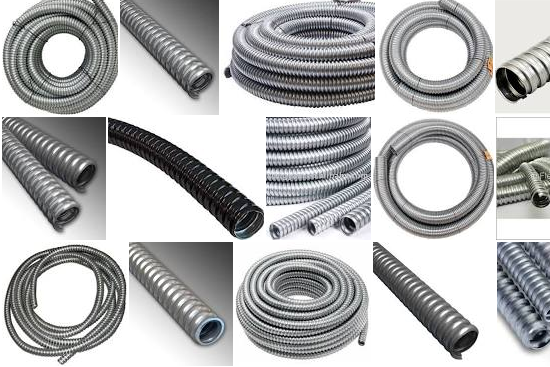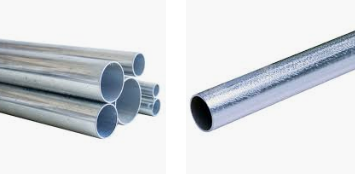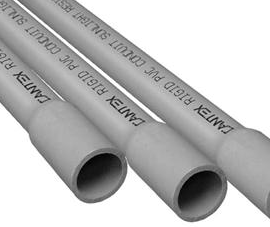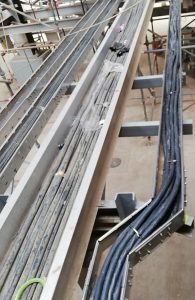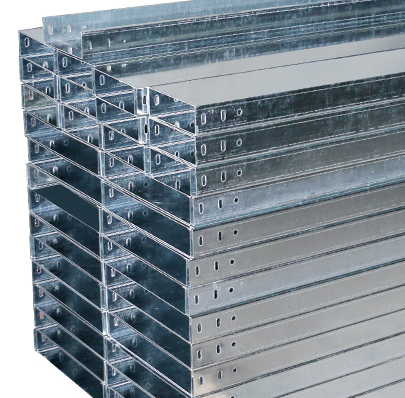This article describes the various types of electrical wiring systems and the selection of a proper wiring system from the standpoint of mechanical design. Main keywords for this article are NEC Wiring System Types – NEC Wireway Systems in Plant Industry. Flexible Metal Conduit. Electrical Metallic Tubing. Intermediate Metal Conduit. Rigid Nonmetallic Conduit. Cable Tray. Busways and Wireways. Underfloor and Cellular Metal Floor Raceways.
References
National Fire Protection Association (NFPA)
70 National Electrical Code (NEC)
Definitions
For the purpose of understanding this standard the following definitions apply.
Grounded Conductor. A circuit conductor that is intentionally grounded.
Grounding Conductor. A conductor used to connect equipment or the grounded circuit of a wiring system to a grounding electrode or electrodes.
NEC Wiring System Types
- Types of wiring systems in general use in the petrochemical industry include:
a) Rigid metal conduit
b) Metal-clad cable (MC)
c) Nonmetallic-sheathed cable (NM) (NMC) (SE) (USE) (UF) (SNM) (TC) (ITC) (PLTC) (MV)
d) Cables installed in trays, (TC) NEC types of cables are included in parenthesis for reference. - Other types of wiring methods used to a lesser extent, and frequently forming a part of one of the above types of wiring systems include:
a. Flexible metal and nonmetallic conduit
b. Liquid tight flexible metal conduit
c. Bus ways and wire ways
d. Under floor and cellular metal fl oor raceways
e. Surface metal raceway
f. Electrical metallic tubing (EMT or thin-wall conduit)
g. Intermediate metal conduit
h. Rigid nonmetallic conduit
i. PVC coated rigid metal conduit - The various wiring systems and uses are covered in the following sections of this standard:
a. Table I Iists the wiring systems and their applicability for the various environmental classifications as defined in NFPA 70, Article 500 Hazardous Locations, Classes I, II, and III, Divisions 1 and 2
b. Table II lists corrosion resistant characteristics of materials and coatings for electrical raceways
c. Table III lists comparative materials, labor, and installed costs of the various types of wiring raceways. The installed cost of hot-dipped galvanized conduit in a general purpose installation is established arbitrarily at 100 percent with the other conduit types and materials scaled to this reference.
d. Table IV is a comparison of interior wiring systems - Where cables are listed in this standard, NEC cable types are used. Both NEC type cable and the IEC equivalent may be used interchangeably.
NEC Wireway Systems
- Rigid Metal Conduit Details
Rigid metal conduit (RMC) is manufactured from tubing, usually steel or aluminum, of standard pipe weight and thickness, which permits cutting standard threads. A rigid conduit system consists of continuous lengths of electrical conduit with outlet boxes, fittings, and pull boxes located at strategic points in the raceway, all installed as a complete system before conductors are pulled in. A rigid metal conduit system provides maximum protection for conductors. When adequately installed, it also provides a dependable protective grounding path for equipment. See NFPA 70 Article 250. However, the conduit system shall not be intentionally used as the grounding conductor. - Rigid Metal Conduit Systems
A rigid metal conduit system can be installed, both exposed and concealed, under all environmental conditions. Different kinds of conduit materials and finishes, and classes of fittings and boxes are used, depending upon the occupancy and environmental conditions.
Flexible Metal Conduit
- Ordinary flexible metal conduit consists of a continuous zinc-plated metal strip spirally wound on itself and interlocked. Liquid tight flexible metal conduit is similarly constructed and covered with a tough, extruded synthetic material.
- Ordinary flexible metal conduit is not waterproof. Liquid tight type should be used in all wet locations except Class I, Division l, hazardous locations where the requirement shall be an approved explosion-proof type (see NFPA 70, Article 501). Flexible metal conduit is usually limited in use to short lengths where flexible connections are required, for example:
a. Between the ends of rigid conduit and terminal boxes on motors that drive equipment where some adjustment is necessary in the drive
b. Between the ends of rigid conduit and terminal box on the equipment, to enable the equipment to be disconnected and removed more readily
c. Between the ends of rigid conduit and machinery, to localize machine vibrations
d. On machinery itself in congested locations where flexible conduit may be installed more easily than rigid conduit - Liquid tight metal conduit is used for connection to motors or other portable equipment where flexibility of the connection is required. It shall not be used under the following conditions:
a. Where subject to mechanical damage
b. Where in contact with rapidly moving parts
c. Under conditions where its temperature, with or without enclosed conductors carrying current, is above its rating (NFPA 70 Article 351). - Flexible nonmetallic conduit is sometimes used instead of metal. Where a grounding conductor is required for the circuit, it may be installed inside or outside the conduit. If installed outside, it shall not exceed 1.8 m, as specified in NFPA 70 Article 351.
Electrical Metallic Tubing (EMT)
- Electrical metallic tubing (EMT or thin-wall conduit) is manufactured from tubing, usually steel or aluminum, in sizes 1.3 cm to 10 cm (1/2 in to 4 in). EMT has the same inside diameter as standard pipe up to 5 cm (2-in) size, but a wall thickness less than one-half that of standard pipe. The thin wall does not allow sufficient stock for cutting threads.
- Complete mechanical protection is provided by this raceway system, but it is not as strong mechanically, nor does it provide as much protection against corrosion as rigid metal conduit.
EMT shall not be used where subject to vibration. EMT shall only be used in non-hazardous locations for building lighting and receptacle wiring.
Intermediate Metal Conduit
- Intermediate Metal Conduit (IMC) is manufactured from mild steel in sizes 13 mm (1/2 in) to 100 mm (4 in). IMC has the same corresponding outside diameter as rigid metal conduit, but a larger interior diameter. The average weight of rigid aluminum conduit is approximately 47 percent of IMC. The average weight of IMC is approximately 73 percent of galvanized steel conduit. The average weight of EMT is approximately 50 to 60 percent of IMC. The installed cost of IMC is approximately equal to that of rigid conduit.
- IMC shall be used only for building light and receptacle wiring in non-hazardous locations.
Rigid Nonmetallic Conduit
- Rigid Nonmetallic Conduit (RNC) and fittings are manufactured from suitable nonmetallic material (PVC) that is resistant to moisture and a wide range of chemical atmospheres.
- RNC shall be minimum schedule 40 and shall only be used in underground concrete duct banks.
Cable Tray
- NFPA 70, Article 318, covers the use of cable trays. Cable installations in trays may be used for exposed work, either inside or outside buildings; in dry or wet locations; and where subject to corrosive vapors, providing the materials of construction and insulation are adequately resistant to deteriorating elements.
- The use of cable tray installations may be prohibited in certain areas by local codes. Power cables and instrumentation cables shall not be run in the same cable tray.
- All cable tray systems should be designed as a complete system, with no physical discontinuities unless totally unavoidable.
- Cable trays shall not be used as a grounding conductor. Cable trays shall be made electrically continuous; section to section and cable tray system to earth. Ground path continuity shall be maintained between sections by the cable tray manufacturer’s splice plates (where certified approved for grounding) or by installation of a bonding jumper.
Busways and Wireways
- Busways and wireways are forms of wiring raceways consisting of sheet-metal troughs with removable covers. A busway contains a single circuit usually of large capacity; in some cases arranged for tapping off at convenient intervals and in other cases, untapped between two points. A wireway is a duct or channel which may contain any number of conductors whose sum of cross-sectional areas does not exceed 20 percent of the interior cross-sectional area of the duct or channel (NFPA 70, Article 362).
- Busways (NFPA 70, Article 364) and wireways (NFPA 70, Article 362) shall be installed only for exposed work. Where used outdoors or in wet locations, they shall be of approved construction, for example raintight or watertight. Busways and wireways shall not be installed where they may be subject to severe physical damage or corrosive vapors. Busways and wireways may be used in Class I, Division 2 locations if they are enclosed and gasketed (NFPA 70, Article 501). Wireways may be used in Class II, Division 2 locations if they are dust-tight (NFPA 70, Article 502).
Underfloor and Cellular Metal Floor Raceways
- Underfloor raceways (NFPA 70, Article 354) are wiring troughs placed in floor slabs of buildings, arranged in a way that outlet fittings may be tapped into the wiring troughs at convenient points in their length. Cellular metal floor raceways (NFPA 70, Article 356) are similar to wiring troughs, except that the metal cells themselves are floor supports for the floor finish.
- Raceways of this kind are usually installed in offices, shops, and laboratory buildings for receptacle, telephone, and signal wiring, and outlets to desks, laboratory tables, and machinery that are not accessible from wall outlets.
